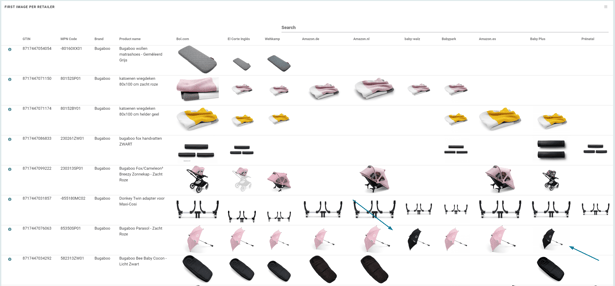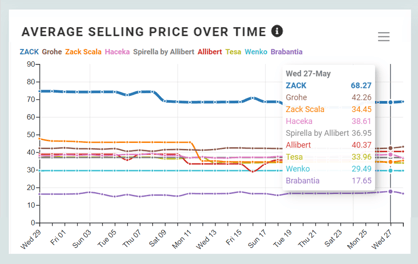Online shopping is not possible without returns, but reducing your unnecessary returns is a necessity in these times and immediately yields a lot. Return reduction has the most significant result on your profitability! Let's look at 6 effective tips that brands and e-retailers can apply to better manage and prevent product returns in eCommerce.
1. Monitor and Enhance Product Copy
Poor product pages result in shoppers who don't buy a product or buy the wrong product based on inaccurate assumptions, resulting in unhappy customers or returned purchases.
When brands come to the point that product content is published on multiple sales channels. They should never believe the job is done!
Is all product information complete and correct on all channels? Checking the quality of product content on all eCommerce channels and each product detail page can bring customer expectations as close as possible to reality.
Checking product pages one by one, that's an awful lot on your plate!
Content monitoring software such as SiteLucent, can identify gaps, inconsistencies, and areas for improvement daily and show you where to improve. Fast and without checking product detail pages one by one!
A strong product description is crucial to boost conversions and prevent returns. SiteLucent helps you to check if product titles and descriptions across 100+ channels:
- Contain your brand name (correctly written)?
- Contain the (correct) color name of your products?
- Display the (correct) dimensions, weight, or wattage?
- Include important search keywords?
- Contain any other important attribute.
2. Spot Missing or Inaccurate Product Images
Showing at least 1 product image is an absolute must on each product detail page! The simplest way to compensate for the lack of touch and focused examination that customers usually have access to while shopping in physical stores is to provide detailed photos of your product. Show (where necessary) how large the article is, for example, by showing the article together with another object or a model or presenting the dimensions visually. This can contribute to your conversion but also helps prevent returns by avoiding a mismatch between shoppers' expectations and reality.
With SiteLucent, you can determine which products are missing images online. This way, you do not need to check product pages manually. You probably do not want to waste time and contact the reseller or take another action right away.
Next to having a good amount of images, the quality of the images matter. Nice to haves are enlarged views and zoom functionalities, rotated or detailed pictures, or animated images of products in use.
Get the basics right!
You can show the most stunning product images, but it won't prevent a shopper from returning a product if you don't get the basics right!
Look at the example of Bugaboo below. The SiteLucent data table shows all first/main images that are displayed on retailer sites.

Online retailers Baby-Walz and Baby Plus display an image of the Bugaboo Parasol - Soft Pink - different from what the product name claims.
Can you spot the differences?
3. Utilize Valuable Customer Reviews
You can prevent customer inquiries from not being answered by providing clear and accurate product information. According to PowerReviews, 86% of all customers consider reviews as an essential resource when making purchase decisions.
Shoppers trust recommendations from other consumers above anything else!
Examples:
Learn from reviews as input for product development and align product and marketing content with the language used by consumers. Examples of reviews that give retailers and manufacturers input for updating product content, and in addition to that, lower return rates:
- A review on bol.com about a Philips coffee machine: "The content of the water tank is listed as 0.9 liters, but it really isn't.
At most 4 cups come out."
Update your description by not only pointing out the capacity in liters but in actual coffee cups! That is what we mean by 'language used by customers'.
- A review on bol.com about a Philips Light Bulb: "It says in the description, dimmable with suitable dimmer. Not with my LED dimmer. Lamps keep flashing."
Customers do not know what a suitable dimmer is. Describe more clearly in your copy which conditions such a dimmer must meet.
Using review monitoring software gives brands and retailers solutions to track what customers are saying about your products online constantly.
- A minimum of 10 reviews per product can help consumers make better purchase decisions.
- Zoom in on categories for which reviews are extra important, such as NPIs, Health-related products, expensive products, technically complicated products.
- Save time each week reading, sharing, and responding to customer reviews.
- Improve or remove products and pages with negative reviews to avoid a mismatch between expectation and reality and protect your brand reputation online.
4. Keep Prices Competitive and Stable
One of the most important factors in making a purchase decision is still the price. In Wunderman Thompson's Future Shopping Report, 98% of online shoppers cite price as their key factor.
When prices are not stable, shoppers might know this and wait to purchase until a price drop. Those who already bought the products and saw the price drop feel cheated, which results in higher returns and degradation of your brands' reputation.
How do your prices compare to your competitors' prices?

Monitoring your competitors' prices can help you stay competitive in the dynamic eCommerce world. If a customer found a cheaper alternative elsewhere, he might return your product within the (due to corona pandemic increasingly longer) return windows.
Track resellers of your products, competitors, and their prices to avoid price battles:
- Protect your brand reputation and margins.
- Spot 3P sellers, non-compliant or unauthorized sellers.
5. Clear Return Policy
In the customer's purchase journey, you must communicate clearly about your return policy. Without this information, not every customer will purchase in your online store. The proper handling of a return shipment from a customer can also lead to a higher chance that this customer will return to you. Sending an online return leads to a follow-up purchase in 44% of the cases. If you return the returned product to a store, this is even 66%. The focus on returns can, therefore, also help drive your sales.
Make sure you analyze your return data and address the products with the highest return rates and volumes. High return rates have a bad influence on winning the buy box on marketplaces!
6. Availability & Delivery Time
Shoppers cannot buy products if they're not available for purchase. Retailers should monitor if products are in stock so that shoppers don't go for an alternative, get disappointed, and return their products.
You can benefit from monitoring if your resellers communicate a clear delivery time and stock text. Once shoppers order a product online, they want it, and they want it fast! On average global consumers expect to wait less than three days (2.85) for their order to be delivered (Wunderman Thompson's future shopping report).
Those who already bought your products and the delivery time is not as expected feel disappointed, and might order somewhere else and return your product.
Start monitoring the metrics needed to reduce your brands' product returns significantly!
